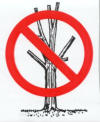 Pruning Landscape Trees - December 31, 2003 Jeff Schalau, County Director, Agent, Agriculture & Natural Resources Arizona Cooperative Extension, Yavapai County There are only three good reasons to prune a landscape tree: to promote a tree’s health; to reduce hazards to people and property; and to train a young tree shortly after planting. Pruning causes a wound in the tree which will impact the tree’s health and/or cause a response. Pruning removes the tree’s foliage which reduces the tree’s ability to create food during photosynthesis. Pruning cuts create potential entry points for disease organisms. Pruning can also reduce vigor and increase sprouting of new branches (not usually good on mature trees). Any or all of these responses could also increase the tree’s susceptibility to insect pests. You must decide whether the desired benefit will override the potential negative effects on the tree. Most coniferous trees (pine, spruce, fir, juniper, cypress, cedar, etc.) have a single dominant leader and do not tolerate pruning. The only pruning that I recommend for these species is to remove dead branches. Deciduous trees vary in their natural growth forms and often have multiple leaders. Deciduous trees (those that lose their leaves) are best pruned when they are young (smaller wounds) and in the winter when they are dormant. In nature, trees do not have a distinct trunk. They often start out looking like a shrub and have small branches along their entire length. These lower branches provide energy to increase trunk diameter and strength. In addition, native grown trees are subjected to wind which further strengthens the trunk through the production of stronger wood. As the tree matures, lower branches are shaded out and die. A strong trunk develops as a result of gradual, natural processes. We can mimic this in our landscapes by planting trees that have some branches along the length of the trunk. If your mature tree has never been pruned, this does not mean that it needs to be. Look for obvious problems: branches that are rubbing together or against structures; parallel branches; dead or broken branches; rotted or diseased wood. These are likely places to consider pruning. Narrow branch angles can have included bark which creates a weak branch attachment. Trees can also get too tall and interfere with structures and/or utility lines. If power service lines are involved, it is best to call your utility company or a trained professional arborist. NEVER TOP TREES! Topping ruins conifers for life. Deciduous trees respond to topping by producing multiple new branches below the cut. These new limbs are weakly attached and break easily in the wind. Re-grown limbs (water sprouts) never have the structural integrity of a well-attached, natural limb. Topping also promotes spread of disease, makes legitimate tree care professionals look stupid, and always results in an ugly tree. In addition, do NOT prune a tree simply because the neighbors are doing it. If you make the decision to prune a moderate to large branch, start by making a slight undercut above the location of the final cut. The second cut should be on the top of the branch up the branch from the undercut. This cut removes the weight of the branch and prevents bark stripping. The final cut should be just above the branch collar (a slight swollen area at the base of the branch). The branch collar contains tissue that will grow to cover the pruning wound. Pruning paint or sealer is unnecessary. The wound will callous over and heal itself. For more information and pictures describing pruning basics, get the University of Arizona Cooperative Publication: Pruning Deciduous Shade Trees. It is available on the web at ag.arizona.edu/pubs/garden/az1139.pdf or from your local Extension office. Happy New Year! If you have other gardening questions, call the Master Gardener line in the Cottonwood office at 646-9113 ext. 14 or E-mail us at mgardener@verdeonline.com and be sure to include your address and phone number. Find past Backyard Gardener columns or submit column ideas at the Backyard Gardener web site: http://ag.arizona.edu/yavapai/anr/hort/byg/. |